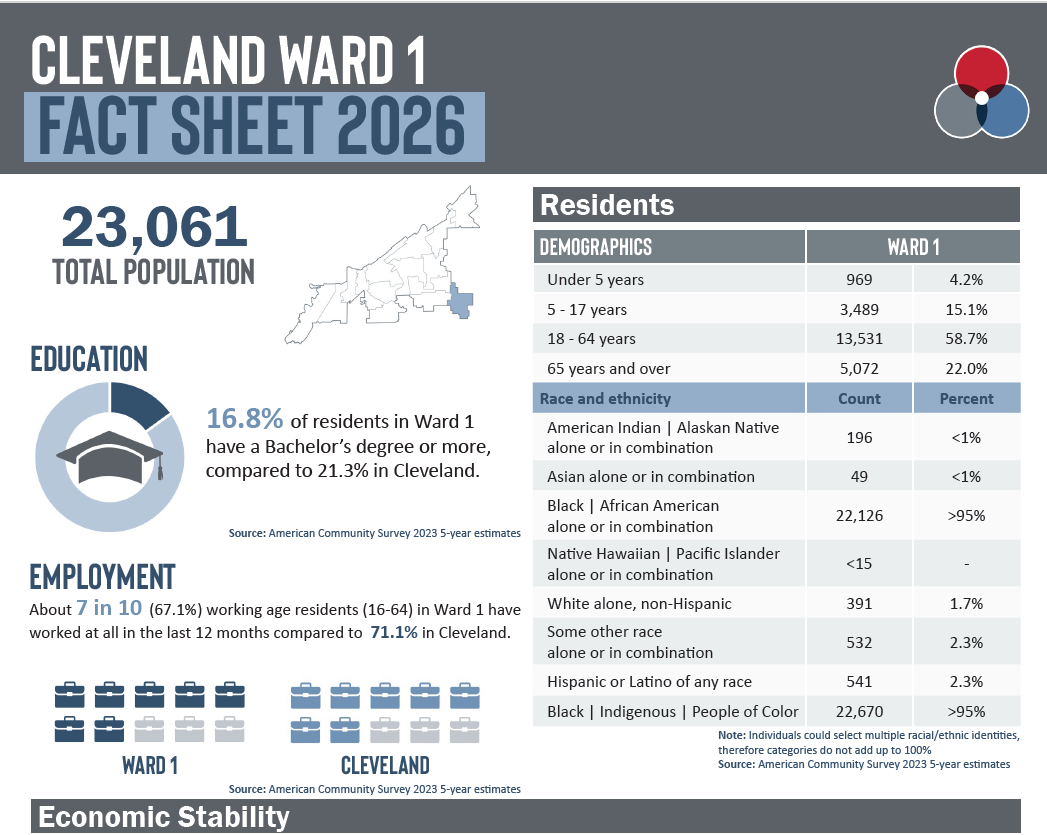.webp)
.png)
.png)
Advancing health, social, and economic issues across Ohio
The Center for Community Solutions is an independent, nonpartisan research center improving health, social, and economic conditions in Ohio through policy, research, and data analysis.
Nonpartisan independent policy and research center focused on health and social services
The Center for Community Solutions is a trusted source of analysis and advocacy with a century-long legacy of pragmatic problem-solving in Ohio’s health and human services landscape.
Policy
Statehouse testimony, education events like the Medicaid Institute, and legislative relationships amplify community voice and help make sense of a complex system.
Research
Surveys, narrative analysis, demographic research, and community health needs assessments reveal changes useful for government and nonprofit organizations.
Data Analysis
Direct service organizations, funders, and policymakers use our analysis to formulate actionable strategies to develop health, social, or economic support for Ohioans.
Transforming data into progress
We help make connections among people and organizations working to improve community conditions and the quality of life of all Ohioans.

Behavioral Health
Ohio ranks 38th in mental health care and overdoses are the leading cause of accidental death. We support behavioral health access with advocacy for destigmatizing mental health, especially for youth, with programs like OhioRISE and the Multi-System Youth initiative.

Maternal & Infant Health
The maternal and infant health crisis is worsening. The March of Dimes gives Ohio a D-rating for preterm births. Comprehensive birth data makes the racial disparities impossible to ignore, so we have focused on Black mothers and babies who suffer from complications more often.

Medicaid
Policies supporting Medicaid are complex and challenging for providers, policymakers, and consumers to understand. We work hard to simplify it, since our Medicaid work intersects with every one of our priority areas. Our Center for Medicaid Policy promotes engagement in health care policy through pragmatic research and analysis.

Poverty & Safety Net
Hunger, public benefits, and tax policies impact Ohio families and their ability to thrive. We lead in research and data analysis on policy, economics, and shifting demographics. We work to strengthen the health and human services safety net by identifying policies can reduce poverty.

Older Adults
Along with the economic instability that may accompany aging, older adults often face social conditions like loneliness, food insecurity, and changes in family support. We work to enhance the well-being of older adults through our research and policy work that improves conditions for Ohio’s older population.
Explore Topics
Browse articles, research reports, fact sheets, and testimony.
Explore the fact sheets
We make data digestible. Community Solutions produces fact sheets highlighting demographic, health, and social indicators for communities around Ohio. We examine data indicators within poverty, education, employment, income, health outcomes, and public benefit programs. Policymakers and direct service organizations use this resource to better understand the communities they serve and advocate for improved health and social conditions around the state.

Cleveland Wards 2026
Cleveland Ward fact sheets and data profiles highlight demographic, health, and social indicators in the new 15 wards in Cleveland. The fact sheets summarize and the data profiles provide extensive information about each ward on employment and income, poverty, education, housing and health. This is the first analysis available for Cleveland's revised wards, now 15 from the prior 17. Data released 2025.

Cleveland Wards 2022
City of Cleveland Ward fact sheets highlight pre-pandemic demographic, health, and social indicators in the City of Cleveland. The fact sheets include basic demographic information about each neighborhood and pre-pandemic data on employment and income, poverty, education, housing and health. Data released 2021 and 2022. Updated with new ward configuration in 2026.

Federal Congressional Districts in Ohio
These fact sheets explore demographics, economic stability, food security, housing, education and employment, health, and funding sources in each of Ohio's 15 Federal Congressional Districts. Data from 2025. Check out the interactive worksheet.

Cuyahoga County Council Districts
Cuyahoga Council District fact sheets highlight demographic, health, and social indicators in the City of Cleveland. The fact sheets summarize and the data profiles provide extensive information about each district on employment and income, poverty, education, housing, and health. Data released 2017 and 2024.

Cleveland Neighborhoods
City of Cleveland Neighborhoods fact sheets and data profiles highlight demographic, health, and social indicators in the City of Cleveland. The fact sheets summarize and the data profiles provide extensive information about each neighborhood on employment and income, poverty, education, housing and health. Data released in 2016, 2021, and 2024.

Cuyahoga County Municipalities
These fact sheets and data profiles highlight demographic, health, and social indicators in the cities, townships, and villages of Cuyahoga County. The fact sheets summarize and the data profiles provide extensive information about each Municipality on employment and income, poverty, education, housing, and health. Data released 2018 and 2024.















